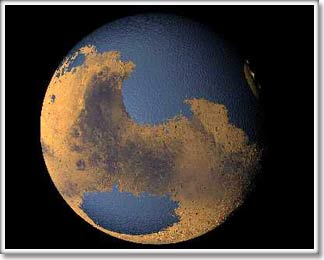Sulfur dioxide helps maintain the flow on Mars
A new study shows that sulfur dioxide (SO 2 ), not CO2, as people think has heated Mars and helped maintain its positive belt.
Scientists still think that Mars is sealed in an early CO 2- rich atmosphere, a condition that creates warm temperatures like on Earth. But according to a study led by Harvard University planetary geochemist Itay Halevy, limestone and other rocks formed from CO2 are absent from the surface of Mars.
Halevy and colleagues said that this could only happen if the volcanoes active on Mars previously emitted SO 2 and H 2 SO 3 .
 SO 2 is such a powerful greenhouse gas that it can acidify Mars' oceans and prevent the formation of carbon minerals. And if this is the main component that controls Mars's climate, life on Mars may not exist because of life formed on carbon compounds.
SO 2 is such a powerful greenhouse gas that it can acidify Mars' oceans and prevent the formation of carbon minerals. And if this is the main component that controls Mars's climate, life on Mars may not exist because of life formed on carbon compounds.
These assumptions are particularly important in the era of humanity trying to find environments that produce life both inside and outside the solar system. This study was published in the journal Science.
Sun dioxide dioxide and greenhouse effect
The research team re-simulated the cycles of sulfur and carbon on Mars about 4 billion years ago when the temperature was only slightly above freezing.
Today, the temperature on Mars is lower than the east and the planet is so cold that polar water exists in the form of ice. Scientists still can't explain why Mars's liquid could last for the first 500 million years when the sun shines weaker than it is now.
Most scientists agree that a greenhouse gas helps maintain water on Mars in channels and other terrain created by water. Greenhouse gases like CO 2 retain heat in a planet's atmosphere and warm the planet's surface.
Halevy argued that SO 2 could be the cause of Mars being warmer in the beginning and an explanation for the absence of carbon compounds, the existence of Martian clay and the sulfate environment and acid in the history of Mars's existence.
On Earth, SO 2 is often rapidly oxidized and exits the atmosphere in the form of acid rain. But in the oxygen-deficient environment of Mars when it was first formed, this gas lasts longer. Volcanic SO 2 gas also plays a similar role on Earth 2.5 to 4 billion years ago when no form of carbon rock was formed.

The incomplete suit?
In his study, Jeffrey Moore, a scientist at the Ames Research Center, NASA in California also outlined a similar possibility: 'Intense SO 2 eruptions of Mars volcano could prevented carbon formation. '
But both Moore and Mark Bullock of Southwest Research Institute in Boulder, Colorado believe that SO 2 emissions from volcanoes may have turned very quickly into sulfuric acid.
According to a recent study, SO 2 may leave a trace in the form of sulfite salts. The hypothesis of Bullock and Moore is that sulfate salts will appear, another byproduct.
Mars expeditions, including the use of Spirit, Opportunity, and the Mars Express or Mars Observer, have obtained evidence of the existence of sulfates on the Martian surface. Moore says, everyone is trying to find sulfite on Mars, but they haven't succeeded yet.
According to Halevy, only a small amount of water, sulfite will be converted into sulfate compounds and basic sulfur. This may explain why Mars expeditions are looking for sulfate and not sulfite.

Mission . of Robot
Astronomer at the University of Southern Paris in Orsay, France Francois Poulet said that this work was 'a study of stature' but needed more research steps.
'SO 2 greenhouse gas has been mentioned in many previous projects. In addition, other greenhouse gases can play an important role in maintaining the hot climate of primitive Mars like ammonia and methane. '
However, Poulet disagreed with the assumption of the absence of sulfite.'I like the hypothesis that explains the formation of sulfate from sulfite deposits. But in any case, their assumptions need to be tested by actual adventures of robots. '
Halevy and colleagues are experimenting with the Mars simulation environment to explain the chemical structure that forms the greenhouse gas SO 2 . The group also studied the formation of a primitive earth environment based on this assumption.
- Find a way to create concrete with materials on Mars
- Rare videos of fantasy sulfur fires but extremely dangerous
- The harmful effects of sulfur that you do not know
- Video: Mars has the ideal conditions to produce oxygen
- Large amounts of carbon dioxide existed on Mars
- Flow-Aid helps farmers save water for irrigation
- NASA confirmed that there was water flowing on Mars
- NASA decodes a mystery on Mars
- Detecting ... elephant head on Mars
- Detecting snow on Mars
- How does Mars smell?
- Elon Musk wants to put the artificial sun on Mars
 Van Allen's belt and evidence that the Apollo 11 mission to the Moon was myth
Van Allen's belt and evidence that the Apollo 11 mission to the Moon was myth The levels of civilization in the universe (Kardashev scale)
The levels of civilization in the universe (Kardashev scale) Today Mars, the sun and the Earth are aligned
Today Mars, the sun and the Earth are aligned The Amazon owner announced a secret plan to build a space base for thousands of people
The Amazon owner announced a secret plan to build a space base for thousands of people